User's Manual
Table Of Contents
- ProSecure Web/Email Security Threat Management (STM) Appliance Reference Manual
- Contents
- About This Manual
- Chapter 1 Introduction
- Chapter 2 Using the Setup Wizard to Provision the STM in Your Network
- Choosing a Deployment Scenario
- Understanding the Steps for Initial Connection
- Logging In to the STM
- Using the Setup Wizard to Perform the Initial Configuration
- Setup Wizard Step 1 of 10: Introduction
- Setup Wizard Step 2 of 11: Networking Settings
- Setup Wizard Step 3 of 11: Time Zone
- Setup Wizard Step 4 of 11: Email Security
- Setup Wizard Step 5 of 11: Web Security
- Setup Wizard Step 6 of 11: Email Notification Server Settings
- Setup Wizard Step 7 of 11: Update Settings
- Setup Wizard Step 8 of 11: HTTP Proxy Settings
- Setup Wizard Step 9 of 11: Web Categories
- Setup Wizard Step 10 of 11: Configuration Summary
- Setup Wizard Step 11 of 11: Restarting the System
- Verifying Proper Installation
- Registering the STM with NETGEAR
- What to Do Next
- Chapter 3 Performing Network and System Management
- Configuring Network Settings
- Configuring Session Limits and Timeouts
- Configuring the HTTP Proxy Settings
- About Users with Administrative and Guest Privileges
- Configuring Remote Management Access
- Using an SNMP Manager
- Managing the Configuration File
- Updating the Software
- Configuring Date and Time Service
- Managing Digital Certificates
- Managing the Quarantine Settings
- Performance Management
- Chapter 4 Content Filtering and Optimizing Scans
- About Content Filtering and Scans
- Configuring E-mail Protection
- Configuring Web and Services Protection
- Configuring Application Control
- Setting Scanning Exclusions and Web Access Exceptions
- Chapter 5 Managing Users, Groups, and Authentication
- About Users, Groups, and Domains
- Configuring Groups
- Configuring User Accounts
- Configuring Authentication
- Global User Settings
- Viewing and Logging Out Active Users
- Chapter 6 Monitoring System Access and Performance
- Chapter 7 Troubleshooting and Using Online Support
- Appendix A Default Settings and Technical Specifications
- Appendix B Related Documents
- Index

ProSecure Web/Email Security Threat Management (STM) Appliance Reference Manual
4-22 Content Filtering and Optimizing Scans
v1.0, September 2009
Configuring Web and Services Protection
The STM lets you configure the following settings to protect the network’s Internet
communication:
• The Web protocols that are scanned for malware threats.
• Actions that are taken when infected Web files or objects are detected.
• The maximum file sizes that are scanned.
• Web objects that are blocked.
• Web categories, keywords, and file types that are filtered to block objectionable or high-risk
content.
• Domains and URLs that are blocked for objectionable or high-risk content.
• Customer notifications and e-mail alerts that are sent when events are detected.
• Schedules that determine when content filtering is active.
Customizing Web Protocol Scan Settings
If you have used the Setup Wizard, you might have already configured the Web protocol scan
settings; the (Web) Policy screen allows you to modify these settings.
Scanning all protocols enhances network security, but might affect the performance of the STM.
For an optimum balance between security and performance, only enable scanning of the most
commonly used protocols on your network. For example, you can scan FTP and HTTP, but not
HTTPS (if this last protocol is not often used). For more information about performance, see
“Performance Management” on page 3-31.
To specify the Web protocols and ports that are scanned for malware threats.
1. Select Web Security > Polices from the menu. The (Web) Policy screen displays (see
Figure 4-9 on page 4-23).










